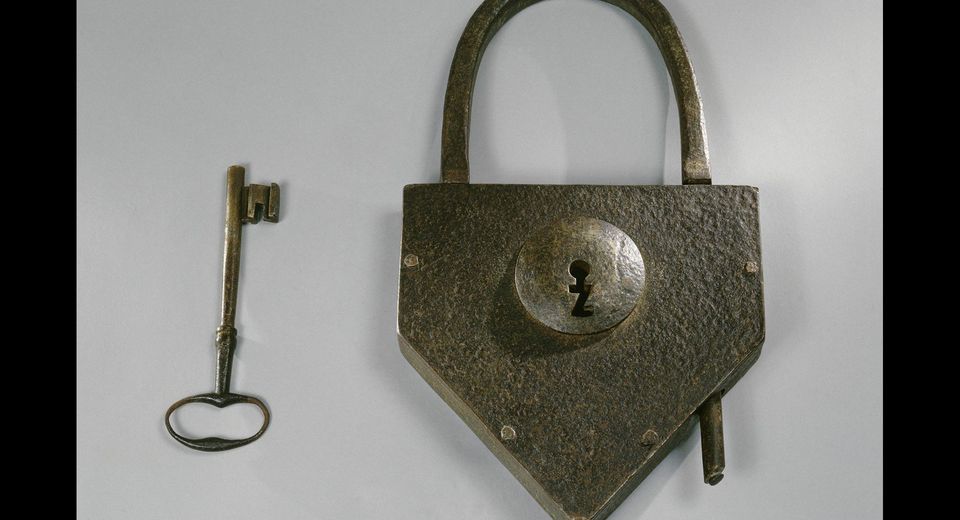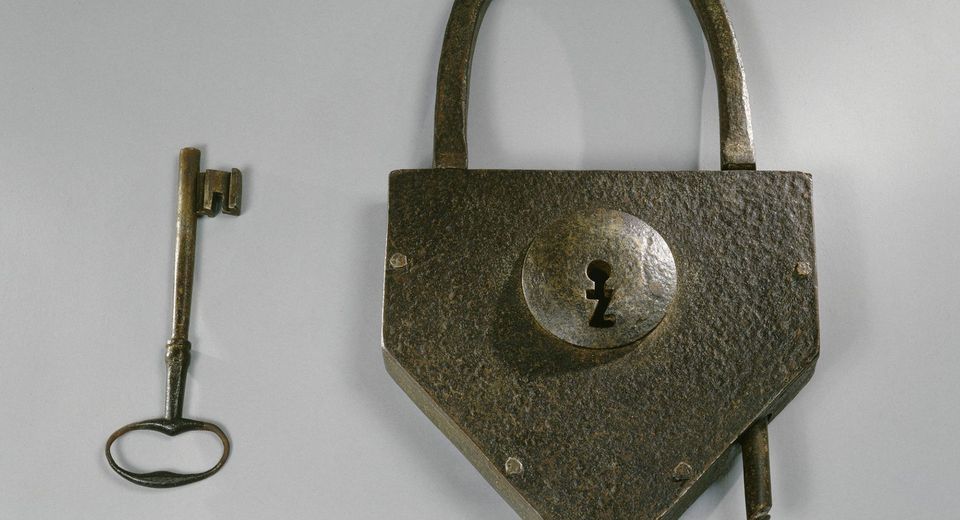Padlock from Brest’s prison
Brest
To prevent any possibility of escape or wandering off, a prisoner was shackled as soon as he got to the prison and his shackles linked to those of another prisoner Discipline, security measures and punishments were harsh.
Brest prison
Following the dissolution of the Galley Corps in 1748, the Navy decided to employ convicts on other tasks, work on improvements to military ports in particular.
Prisons were established wherever naval shipyards existed: Toulon, Rochefort and Brest. Built by the engineer Choquet de Lindu on the left bank of the Penfeld, Brest prison was 260 metres long and could accommodate up to 2,000 convicts.
Convicts
When a convict arrived at the prison, he was provided with a uniform whose colour corresponded to his sentence. Under Louis XVI, a red cap was worn by prisoners serving life sentences, while those serving a given length of time wore green caps. A register containing a detailed description of each man along with his prison number ensured that all inmates were easily recognisable. Each prisoner was permanently shackled to a fellow inmate by means of a chain attached to his ankle, a system that made escape difficult and solitude impossible. If a rule was broken, severe physical punishments were inflicted, including flogging across the shoulders with a tarred rope. Among other things, convicts were used to carry stones and other materials required for construction work in the port, and to clean out the dry docks where ships were built and repaired. They also took part in earthmoving works, such as those required to create Cours Dajot, and in digging the Nantes-Brest Canal. Such work was referred to as “greater or lesser fatigue” depending on its arduousness, and was carried out in the daytime, among the city’s population itself. Some convicts blessed with nimble fingers might also find employment making such small items as needle cases and snuffboxes, craftwork that earned them a few extra handouts.
Tonnerre de Brest!
In 1764, the Count of Roquefeuil, as Naval Commander, set a 24-pounder cannon on the ramparts, which was to be fired in order to warn the population if a prisoner escaped. This method of alerting its citizens may well have been at the origin of the famous French exclamation “Tonnerre de Brest!”, which may be translated as “Shiver me timbers!” Only convicts who had killed or struck a guard or fermented an uprising were executed. There was an average of one execution a year over the course of the 19th century.
Penal colony
Due to the development of France’s colonies over the course of the 19th century, it was decided to deport the convicts to the country’s overseas territories. Between 1850 and 1858, convicts assigned to Brest were shipped off to French Guiana and New Caledonia. The prison was completely empty by the end of 1858. The building, which was damaged but still standing after the airstrikes in 1944, was demolished in 1948.
Over 50,000 convicts were imprisoned in Brest between 1748 and 1858, leaving a lasting impression on its inhabitants’ memories.
A convict’s day
Woken up at five o’clock on summer mornings and six o’clock in winter, the convict had his shackles checked before proceeding to his workplace at around seven or eight o’clock, where he carried out work of “lesser or greater fatigue”. He was not returned to the prison before six in the evening. Some inmates used their spare time crafting objects made of straw or carved in coconuts to sell at the prison bazaar, which was regularly visited by Brest’s’ inhabitants and travellers.
In the evening, each inmate went back to his place on the “tollard”. This was a bench that accommodated 24 men for the night, with each man having just 48 cm of space to sleep, covered by his blanket. At 8 p.m. the signal for silence was given.
Collection highlight
The essential works to see during your visit to the Musée national de la Marine in Brest, Port-Louis, Rochefort, Toulon, and soon in Paris.


